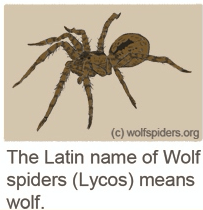The Greek name for wolf is Lycos, and wolf spiders (Lycosidae spp.) are named as such because they were previously thought to hunt in groups, in contrast to spiders catching their prey in webs.
Wolf spiders are also characterized by good vision, females carrying their egg sacs with them (most do), and eight eyes.
How to identify Wolf Spiders
Wolf spiders are a diverse group of ground-dwelling arachnids known for their unique hunting strategies and distinctive physical features. Identifying them can be achieved by examining several key characteristics.
Their body color typically ranges from brown, gray, to black, with patterns often present on the carapace (front part of the body). These patterns serve as camouflage, aiding them in blending in with their surroundings. The area between their upper and lower face may exhibit contrasting colors, adding to their distinctive appearance. Wolf spiders possess chelicerae, or jaws, which may have dark spots or markings, further contributing to their identification.

A crucial feature for recognizing wolf spiders is their eye arrangement. They have eight eyes organized in three rows, with four small eyes on the bottom row, two large, forward-facing eyes in the middle row, and two medium-sized eyes in the top row. This unique configuration sets them apart from other spiders. Some common species of wolf spiders include Hogna carolinensis, Schizocosa avida, and Pardosa spp. These species vary in size, coloration, and patterns, making it essential to consider multiple features when identifying them.
Wolf spiders have a wide distribution, inhabiting various environments such as grasslands, forests, wetlands, deserts, and human-made landscapes like gardens and agricultural fields. Their adaptability and diverse range make them one of the most common and recognizable spider families found across the globe.
Legs

Wolf spiders are diurnal animals, They have eight long, hairy legs, of which the front legs are large and strong, allowing them to move quickly and efficiently on different terrains. They use their strong cheliceraes to crush prey, and they can inflict sharp stinging bites on humans.
They are very fast and can reach a speed of two feet per second over short distances. (1)
Appearance
Wolf spiders have a brown or dark coloration with bristles on their legs and body, which makes some species look a bit like tarantulas, but they are in fact very different. As there are many different wolf spider species, their appearances vary a lot. Consult the picture section and see also the latest photo submitted to this site (by Robert McDonald).
Size
Wolf spiders can reach a size of up to 1.2 inches (30.48mm). That is the body size only – if the legs are included the total length of a Wolf Spider can be almost four inches.
Eyes
Wolf spiders depend on their sight and have eight eyes in total, and of these are two very large. Above them, and laterally, they have two smaller eyes – and below the two large eyes, in a middle row, a row of four relatively small eyes is seen.

Although they have a good vision, they cannot discriminate between e.g. a finger and an insect; erroneously, this has lead to the wrong conclusion that Wolf spiders are naturally aggressive which they are not. (2)
Eggs
However, the most pronounced feature of Wolf spiders is that females carry their egg sacs and spiderlings with them. The sac is attached to the spinnerets at the end of the abdomen and the female Wolf Spider keeps her abdomen in a position that prevents the eggs from being damaged. The egg sacs are white and occasionally even blueish. When the spiderlings are ready to hatch, she opens the egg sacs with her jaws. However, a few species (Arctosa, Trochosa and Alopecosa) hides their eggs underground and do not carry them with them.
The spiderlings attach themselves to the top of the females abdomen, and until their first change of skin they will stay with their mother. She will hunt with the spiders attached to her and provide her offspring with the necessary protection.
Glooming eyes

A unique feature of the wolf spiders is that their eyes reflect light well, so if you bring a flash light with you into Wolf spider territory, you will probably see some spider eyes.
Wolf spider’s way of hunting
- Ambush and stalking: Wolf spiders are primarily nocturnal, which means they are most active during the night. They usually wait for their prey to come close or actively stalk it, using their well-camouflaged body to blend in with their surroundings. Their unique eye arrangement allows them to detect movement and changes in light, enabling them to spot potential prey from a distance.
- Speed and agility: When a potential prey item comes within range, the wolf spider relies on its impressive speed and agility to pounce. They can close in on food and grab it with their sturdy legs and spines because they move speedily.
- Use of venom: Once the wolf spider has captured its prey, it uses its venomous fangs (chelicerae) to immobilize and kill it. The venom is injected into the prey, causing it to become paralyzed. The wolf spider then begins to consume the prey by injecting digestive enzymes that liquefy the insides, allowing the spider to suck up the nutrients.
- Tactile and vibrational cues: In addition to their excellent vision, wolf spiders are also sensitive to vibrations and tactile cues in their environment. They can detect the presence of prey through vibrations in the ground or on the surfaces they are walking on. This ability to perceive subtle movements in their surroundings aids in their hunting success.
- Solitary hunters: Wolf spiders are solitary hunters and do not typically work together to capture prey. Each individual spider is responsible for finding and subduing its own food.
- Prey selection: Wolf spiders primarily feed on insects and other small invertebrates such as ants, beetles, crickets, and spiders. Occasionally, larger species of wolf spiders may also consume small vertebrates like lizards or frogs.
Habitat
For some people wolf spiders are a common pest in their homes, and it is true that in the fall they look for warm places to sleep through the winter. Wolf spiders are found on the ground in almost any terrestrial habitat. They of course prefer places were prey can be found such as around doors, near plants, windows, humid basements, and garages. Away from suburban gardens, they can be found in nearly all habitats. Wolf spiders disperse aerially and they are quite mobile too, so they are found almost everywhere.
The life history of the wolf spider
The life history of the wolf spider is marked by unique reproductive and parental behaviors. After mating, the female creates an egg sac, which is typically round or disc-shaped and made of silk. She attaches this sac to her spinnerets and carries it with her, ensuring its protection. The spiderlings crawl onto their mother’s back after hatching and stay there until they can care for themselves. This high level of parental care is relatively unusual among spiders, as most other species provide little to no care for their offspring. Wolf spiders generally have a lifespan of around two years, during which they contribute significantly to the control of insect populations in their respective ecosystems.
Distribution
The 125 species of Wolf spiders in the USA can be found all across the country and wolf spiders are one of the most abundant spiders in the US. They are extremely common in California and some even call them California Wolf spiders. In Texas they have the Texas Rabid Wolf spider which is one of the biggest spiders of Texas.
Behaviors and adaptations
Wolf spiders are known for their wandering nature, often roaming their environment in search of prey. Some species exhibit unique behaviors, such as constructing caves or burrows for shelter. These caves may be left open or feature trapdoors, depending on the species. In arid regions, certain wolf spider species adapt by building watchtowers to protect themselves from floodwaters during rainy periods. Meanwhile, other species are known to use small stones or cobblestones to fill and fortify their burrows, showcasing their adaptability and resourcefulness.
In forest habitats, some wolf spider species utilize branches to create a protective fence around the entrance of their caves, offering additional security from potential threats. An example of such adaptation is the Gray Wolf Spider (Dingosa simsoni). This species constructs a cave with a circular trapdoor, which is often left open while the spider is actively hunting. This behavioral adaptation allows the spider to maintain a secure shelter while still being able to engage in its natural hunting activities.
Diet & Feeding
Wolf spiders predominantly consume invertebrates, with insects forming a major part of their diet. Although they primarily target insects, they may also attack small vertebrates when the opportunity arises. Remarkably, species such as Venatrix lapidosa and Allocosa obscuroides have been reported to bite and kill large toads, highlighting their versatile feeding behavior and adaptability in various environments.
Reproduction, courtship, and mating
The male wolf spider is smaller than the female, so to avoid any trouble the male approaches the female with caution. and weaves his front legs to identify himself and make his intentions clear. If lucky he is not eaten and it must be noted that not all wolf spiders are cannibalistic.
According to a study by Lomborg & Toft (2009) (4) the courtship behavior includes encircling, jumping around and vibrating with both palps and the abdomen. The mating itself takes place with the male facing the female hind part while penetrating her genital opening with a palp containing his semen. The female can carry the male him during mating because he is much smaller than her.
Wolf spiders bites
Wolf spiders are in principle venomous and their venom is poisonous. Bites that penetrates the skin can cause pain, swelling and itchiness. Some people only experience the symptoms for a few minutes, while others get a wound that takes a few days to heal.

Until around 1990 wolf spider bites were treated with antivenom but that stopped when a study showed it was unnecessary. That is also why it is a little bit confusing to answer if this spider is venomous, or poisonous, because it really is. It is just not venomous enough to inflict serious damage to people due to its venom.

The bite may in itself be infectious if proper actions are not taken. A survey showed (Isbister & Framenau, 2004) (3) that the median duration of acute pain from wolf spider bites were 10 minutes. Even so, Wolf spider bites should be avoided.

If you are bitten by a wolf spider the chances are that it is a rather large specimen, as smaller specimens do not have the power to penetrate skin. If the bite has penetrated your skin, and it is a wolf spider, you will probably experience a swelling around the site of the bite. Pain from bites are caused by mechanical trauma, not venom, as it is weak.
Necrotic arachnidism
Necrotic arachnidism is usually attributed to wolf spider bites (Isbister ‘ Framenau, 2004) (3). In a study they showed that approx. 24 % of all wolf spider bites could be considered severe, but that wolf spider bites did not cause necrosis (death of tissue), and that the pain associated with wolf spider bites is mainly due to mechanical trauma. In the same study they also found that the median duration of pain is 10 minutes only.
A study in Toxicon also showed (Ribeiro et al., 1990) (6) that “No local necrosis, a severe complication described in the previous literature, was detected, suggesting that those old cases were due to misdiagnosed Loxosceles (brown recluse spider) spider bites”.
Another study (Campbell et al., 1987) (2) reported that bites from North American wolf spiders are generally mild, and that any mild cause of skin necrosis is due to the bite itself, and not the venom.
Cannibalistic behavior
Recent research has shown that male wolf Spiders cannibalize on older female wolf spiders (5). The study shows that male wolf Spiders occasionally preyed or mated bypassing female wolf Spiders, and that older female wolf Spiders had a larger chance of being eaten than young female wolf spiders. The research team hypothesize that this behavior improves the reproductive success of males, as they eat females with a lower reproductive value and mate with females with a higher reproductive success.
News
Wolf spiders migrating indoor (September 22, 2012)
According to entomologists, wolf spiders are migrating indoors in greater numbers than ever seen before. The reason is believed to be the high temperature that has plagued the country for the past few weeks. Seal cracks and shut doors and windows if you want to keep them out – or make sure that your home is not a suitable for the insects that wolf spiders feed on.
References
1. Ed. Tavolacci, J. Insects and Spiders of the World 10 (2003)
2. Campbell, D.S., Rees, R.S & King, L.E. Wolf Spider Bites. Cutis 39(2) pp. 113-114 (1987)
3. Isbister, G.K. & Framenau, V.W. Australian Wolf Spider Bites (Lycosidae): Clinical Effects and Influence of Species on Bite Circumstances. Journal of Toxicology Clinical Toxicology 42(2) pp. 153-161 (2004)
4. Lomborg, J.P & Toft, S. Nutritional enrichment increases courtship intensity and improves mating success in male spiders. Behavioral Ecology 20(4) pp 700-708 (2009)
5. Aisenberg, A., Costa, F., Macarena, G. Male sexual cannibalism in a sand-dwelling wolf spider with sex role reversal Biological Journal of the Linnean Society (2011)
6. Ribeiro, LA, Jorge, MT, Piesco, RV, et al. Wolf spider bites in Sao-Paulo, Brazil – A Clinical and Epidemiologic-study of 515 Cases. Toxicon 28(6) pp. 715-717 (1990)
7. Wolf Spiders – The Australian Museum
8. Wolf Spiders (wolfspider) | Nebraska Extension in Lancaster County




